MSI Big Bang-XPower II X79 Review – A World of Novelty Heatsinks
by Ian Cutress on February 25, 2012 3:00 PM EST- Posted in
- Motherboards
- MSI
- X79
Test Setup
| Processor |
Intel Sandy Bridge-E i7-3960X 6 Cores, 12 Threads, 3.3 GHz (3.9 GHz Turbo) |
| Motherboards | MSI Big Bang-XPower II X79 |
| Cooling | Intel All-In-One Liquid Cooler, made by Asetek |
| Power Supply | Silverstone 1000W 80 PLUS Silver |
| Memory | G.Skill RipjawsZ DDR3-1866 9-10-9-28 1.5 V 4x4 GB Kit |
| Memory Settings | XMP |
| Video Cards |
XFX HD 5850 1GB ECS GTX 580 1536MB |
| Video Drivers |
Catalyst 11.8 NVIDIA Drivers 285.62 |
| Hard Drive | Micron RealSSD C300 256GB |
| Optical Drive | LG GH22NS50 |
| Case | Open Test Bed - CoolerMaster Lab V1.0 |
| Operating System | Windows 7 64-bit |
| SATA Testing | Micron RealSSD C300 256GB |
| USB 2/3 Testing | Patriot 64GB SuperSonic USB 3.0 |
Power Consumption
Power consumption was tested on the system as a whole with a wall meter connected to the power supply, while in a dual GPU configuration. This method allows us to compare the power management of the UEFI and the board to supply components with power under load, and includes typical PSU losses due to efficiency. These are the real world values that consumers may expect from a typical system (minus the monitor) using this motherboard.
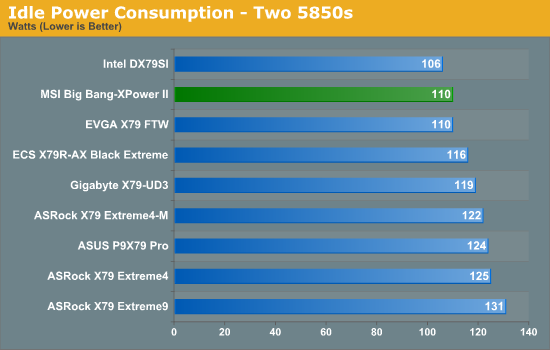
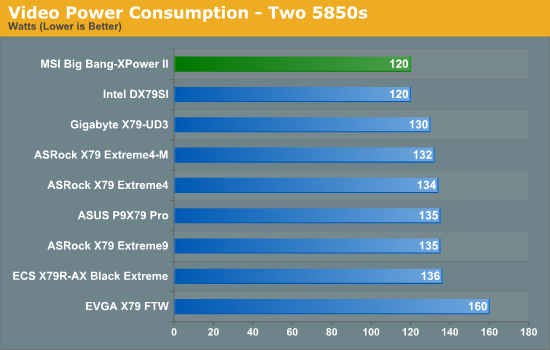

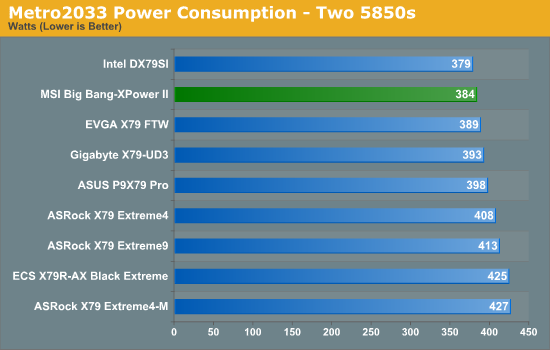
For an XL-ATX board, the MSI BBXP2 is spot on in its power consumption, being the most energy efficient (or the second most efficient) by default compared to other X79 boards tested.
CPU Temperatures
With most users’ running boards on purely default BIOS settings, we are running at default settings for the CPU temperature tests. This is, in our outward view, an indication of how well (or how adventurous) the vendor has their BIOS configured on automatic settings. With a certain number of vendors not making CPU voltage, turbo voltage or LLC options configurable to the end user, which would directly affect power consumption and CPU temperatures at various usage levels, we find the test appropriate for the majority of cases. This does conflict somewhat with some vendors' methodology of providing a list of 'suggested' settings for reviewers to use. But unless those settings being implemented automatically for the end user, all these settings do for us it attempt to skew the results, and thus provide an unbalanced 'out of the box' result list to the readers who will rely on those default settings to make a judgment. CPU Temperatures are not really indicative of quality or performance, even though one would postulate that worse parts may produce higher temperatures. However, if a manufacturer uses more conductive material in the power plane, this reduces resistance and increases the voltage at the CPU, causing a higher temperature but potentially better stability.
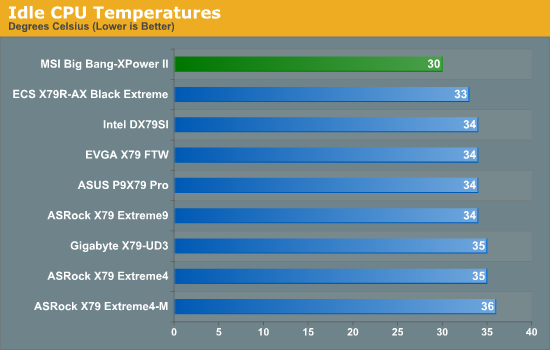
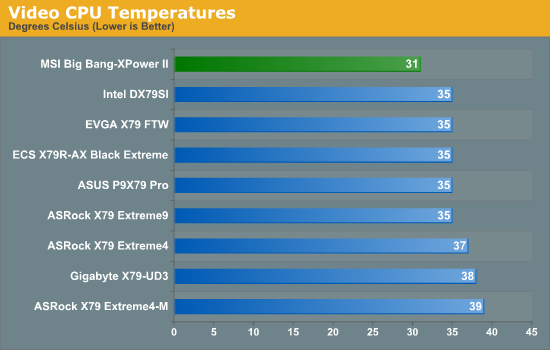
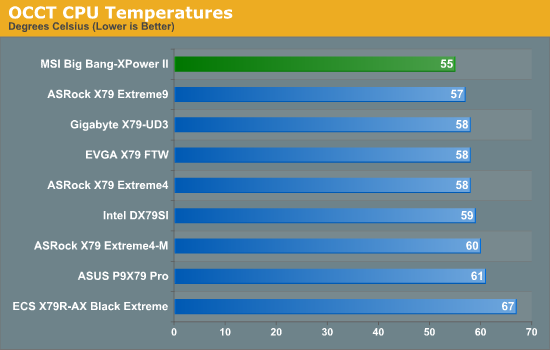
Impressively, the novelty heatsinks on the MSI seem to work wonders, producing our lowest ever CPU temperatures in idle, video and OCCT mode.










45 Comments
View All Comments
Iketh - Sunday, February 26, 2012 - link
I disagree. Onboard X-Fi is far better than the regular ALC codecs, and I'm saying that with my living room computer using a $160 shielded X-Fi PCIe card and my personal desktop using the Asus ROG. I can't tell the difference between the 2 using the same 5.1 setup.I'm also not touching Asus' sound solutions just based on reviews of their products at retailers. Granted, I haven't looked at every model from them.
I agree that I'd rather not have any sound solution on the motherboard, unless of course it's a full discreet solution integrated in the board. But like I said, I'm very happy with the X-Fi chip in the ROGs.
Iketh - Sunday, February 26, 2012 - link
Also, what daughter card are you speaking of? Asus has the X-Fi on the board, and that's on a micro-atx form factor.DanNeely - Sunday, February 26, 2012 - link
Intel NICs are more expensive than Marvell/Realtek NICs and very few people actually know enough to care.TerdFerguson - Saturday, February 25, 2012 - link
That the reviewer very mistakenly thinks that BIOS flashback, SSD caching, better fan controls, and an auto-overclock system are worth $70 alone illustrates how worthless his opinions and reviews are to me and to most users.OwnedKThxBye - Sunday, February 26, 2012 - link
You illustrate how worthless your opinion is by not being able to read the review correctly.The board looks great apart from the heatsinks. Love the review Ian.
Sabresiberian - Sunday, February 26, 2012 - link
The MSI mainboard is also capable of quad SLI, whereas the Asus board is not.As far as someone who likes to call himself "TerdFerguson" speaking for most other Anandtech users - I suggest your opinion of yourself is grossly over-inflated. The only fault that I find hear is that some Anandtech moderator hasn't required you to change your name to something less tasteless.
;)
IceDread - Monday, February 27, 2012 - link
You do not care about micro stuttering do you? Using three graphic cards... no thanks.pandemonium - Wednesday, February 29, 2012 - link
Umm, what?"Amazingly, the three-way setup has a tremendous advantage over two cards in CrossFire."
http://www.tomshardware.com/reviews/radeon-geforce...
Sabresiberian - Sunday, February 26, 2012 - link
It's good to see MSI producing top-level boards again. Most of my builds pre-Nehalem were based on MSI products, but my last 2 builds were not in part because MSI had nothing competitive to offer at the time (for my particular purposes). Good job MSI!;)
thetuna - Sunday, February 26, 2012 - link
"This is in comparison to the audio, which is only the ALC898"What's that X-Fi I see?